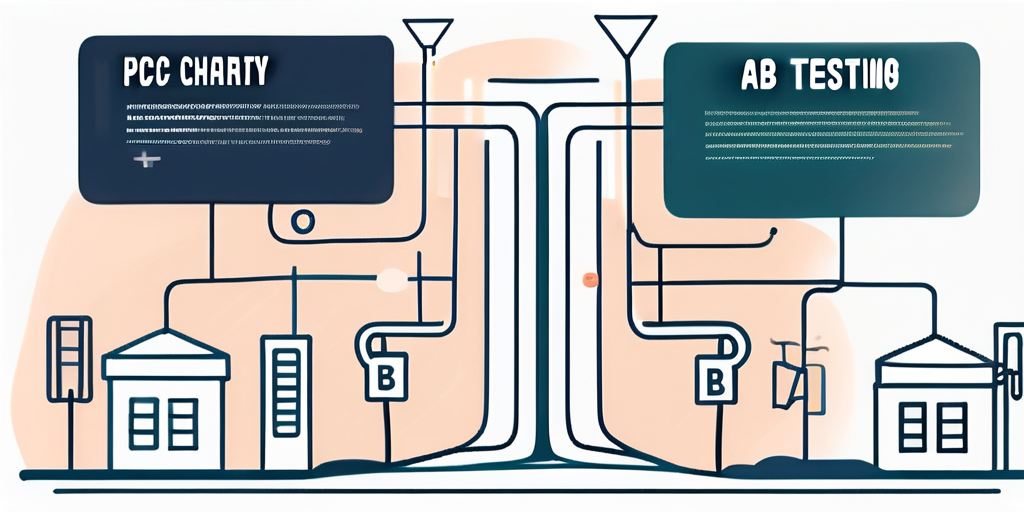The Power of A/B Testing in Nonprofit PPC Campaigns

Nonprofit organizations face unique challenges when it comes to running efficient and effective Pay-Per-Click (PPC) campaigns. Limited resources and tight budgets make it crucial for nonprofits to maximize their advertising efforts. This is where A/B testing comes in. A/B testing is a powerful tool that allows organizations to optimize their PPC campaigns and achieve better results.
Understanding A/B Testing
A/B testing, also known as split testing, is a method where two or more versions of an ad or a webpage are compared to determine which one performs better. The versions, known as A and B, are shown to different segments of the audience, and their responses are measured. By analyzing the data, nonprofits can make data-driven decisions and improve their campaign effectiveness.
The Basics of A/B Testing
A/B testing involves creating two or more variations of an element in the campaign, such as an ad headline, call-to-action, or landing page design. The variations are randomly shown to different subsets of the target audience. Key performance metrics, such as click-through rates (CTR) or conversion rates, are compared to determine which version performs best.
Let’s dive a little deeper into the process of A/B testing. Once the variations are created, they are implemented and shown simultaneously to the audience. The responses are carefully tracked and measured, providing valuable insights into user behavior and preferences. This iterative process allows nonprofits to refine their campaigns and optimize their messaging for maximum impact.
The beauty of A/B testing lies in its simplicity. By testing one element at a time, nonprofits can isolate the impact of each change and gain valuable insights into what works and what doesn’t. This methodical approach helps organizations make informed decisions based on concrete data, rather than relying on guesswork or assumptions.
Why A/B Testing is Crucial for Nonprofits
A/B testing is particularly important for nonprofit organizations. With limited resources, every dollar spent on advertising needs to count. By optimizing their PPC campaigns through A/B testing, nonprofits can ensure that their messages resonate with their target audience, driving more clicks, engagements, and ultimately, conversions. This translates into a higher return on investment (ROI) and a greater impact on their cause.
Moreover, A/B testing empowers nonprofits to understand their audience better. By analyzing the data collected from different variations, organizations can gain insights into the preferences, behaviors, and motivations of their target audience. This knowledge can then be used to tailor future campaigns and create more personalized experiences for potential donors or supporters.
Nonprofits can also use A/B testing to experiment with different strategies and approaches. By testing various elements, such as different messaging tones, imagery, or even donation amounts, organizations can uncover new insights and discover innovative ways to engage with their audience. This continuous experimentation fosters a culture of learning and improvement, enabling nonprofits to stay ahead in an ever-evolving digital landscape.
The Role of PPC in Nonprofit Organizations
Before delving into the power of A/B testing, it’s important to understand the role that PPC campaigns play in nonprofit organizations.
PPC, or pay-per-click, campaigns involve placing ads on search engines, social media platforms, or other websites. Nonprofits can target specific keywords or demographics to reach their intended audience. The ads are shown to users who are actively searching or browsing for relevant topics, increasing the likelihood of engagement.
But what exactly are the benefits of PPC for nonprofit organizations? Let’s take a closer look.
Benefits of PPC for Nonprofits
PPC campaigns offer several benefits to nonprofit organizations. First and foremost, they provide instant visibility and exposure. Unlike traditional fundraising efforts, PPC campaigns allow nonprofits to reach a larger audience quickly and efficiently.
Imagine a nonprofit organization that aims to raise awareness about a particular cause. With PPC, they can create compelling ads that appear when users search for related keywords. This means that people who are actively interested in the cause will see the ads, increasing the chances of them clicking through to the organization’s website or taking some other desired action.
Furthermore, PPC campaigns enable nonprofits to control their advertising budget. They only pay when someone clicks on their ads, ensuring that their resources are used effectively. This is particularly important for organizations with limited funds, as it allows them to allocate their budget strategically and maximize their impact.
Additionally, PPC platforms provide detailed analytics, allowing nonprofits to track their campaign performance and make informed decisions. Nonprofits can monitor metrics such as click-through rates, conversion rates, and cost per click to evaluate the effectiveness of their campaigns. This data-driven approach empowers organizations to optimize their ads, refine their targeting, and ultimately achieve better results.
In summary, PPC campaigns are a valuable tool for nonprofit organizations. They offer instant visibility, control over advertising budget, and access to detailed analytics. By leveraging the power of PPC, nonprofits can effectively reach their target audience, raise awareness for their cause, and drive meaningful engagement.
Integrating A/B Testing into PPC Campaigns
Now that we understand the importance of A/B testing and the role of PPC campaigns in nonprofit organizations, let’s explore how to integrate A/B testing into these campaigns.
Steps to Implement A/B Testing
Implementing A/B testing in PPC campaigns involves a systematic approach. Here are the key steps to follow:
- Identify the elements to test: Start by selecting the elements you want to test, such as ad headlines, ad copy, landing page design, or call-to-action buttons. Choose elements that have a significant impact on campaign performance.
- Create variations: Develop multiple versions of the chosen elements, ensuring that each version has a distinct difference. For example, you may have two different headlines or different variations of landing page designs.
- Randomly assign segments: Split your target audience into random segments and assign each segment to see a specific variation. This ensures that the results are unbiased and reflect the preferences of the larger audience.
- Run the test: Launch your PPC campaign and monitor the performance of each variation. Collect data on key metrics, such as CTRs and conversion rates, to determine which version performs better.
- Analyze the results: Once you have collected enough data, analyze the results to identify the winning variation. Look for statistical significance to ensure that the results are reliable.
- Implement the winner: Based on the results, implement the winning variation across your PPC campaign. This will optimize your campaign performance and drive better results.
Measuring the Success of A/B Tests
Measuring the success of A/B tests involves using key performance indicators (KPIs) to evaluate the impact of the variations. Some common KPIs include click-through rates, conversion rates, engagement metrics, and ROI. By comparing these metrics between the different variations, nonprofits can determine the effectiveness of their A/B tests.
Optimizing Nonprofit PPC Campaigns with A/B Testing
Now that you understand the implementation process, let’s explore some strategies for effective A/B testing in nonprofit PPC campaigns.
Strategies for Effective A/B Testing
Effective A/B testing requires careful planning and execution. Here are some strategies to consider:
- Focus on high-impact elements: Start by testing elements that have the most significant impact on campaign performance. By optimizing these elements, you can achieve substantial improvements in your results.
- Test one element at a time: To accurately measure the impact of each change, test one element at a time. This allows you to isolate the effects and gain valuable insights.
- Consider the buyer’s journey: A/B testing should not be limited to ads or landing pages. Consider testing elements throughout the buyer’s journey, including email campaigns, donation forms, or thank-you pages.
- Keep testing: A/B testing is an ongoing process. Continuously test and optimize your PPC campaigns to ensure that you are always improving performance.
Common Pitfalls to Avoid in A/B Testing
While A/B testing can yield powerful results, it’s essential to avoid common pitfalls that can compromise the accuracy of your tests. Here are some pitfalls to be aware of:
- Insufficient sample size: Ensure that you have a sufficiently large sample size to obtain reliable results. Tests conducted on a small audience may not represent the broader population accurately.
- Ignoring statistical significance: Look for statistical significance when analyzing the results. A change may appear to be positive, but without statistical significance, it may not be reliable.
- Not considering context: Remember to consider the context of your tests. What works in one campaign may not necessarily work in another. Take into account the unique characteristics and preferences of your target audience.
- Ignoring qualitative data: While quantitative data provides valuable insights, don’t overlook qualitative data and user feedback. Feedback from users can offer additional context and help you understand the reasons behind the quantitative results.
Future Perspectives: A/B Testing and Nonprofit PPC Campaigns
As technology continues to evolve, so does the field of A/B testing and nonprofit PPC campaigns. Let’s take a look at some future perspectives.
Trends in A/B Testing
One emerging trend in A/B testing is the use of machine learning algorithms to automate the testing process. These algorithms can analyze vast amounts of data and identify patterns and trends quickly.
Another trend is the integration of A/B testing with other marketing automation tools. This allows nonprofits to streamline their testing processes and gather additional insights from their campaigns.
The Future of PPC for Nonprofits
Looking ahead, the future of PPC for nonprofits is promising. With advancements in targeting capabilities, personalization, and automation, nonprofits can further optimize their campaigns for better results. Additionally, the increasing popularity of mobile devices and voice search presents new opportunities for nonprofits to reach their target audience.
Overall, A/B testing will continue to play a crucial role in helping nonprofit organizations make data-driven decisions and maximize the impact of their PPC campaigns.
In conclusion, A/B testing is a powerful tool that nonprofit organizations can leverage to optimize their PPC campaigns. By understanding the basics of A/B testing, integrating it into their campaigns, and following effective strategies, nonprofits can improve their campaign performance and make a greater impact on their cause. As technology advances, A/B testing will continue to evolve, shaping the future of nonprofit PPC campaigns. By embracing this testing method and staying ahead of the trends, nonprofits can unlock the full potential of their advertising efforts.
Ready to elevate your nonprofit’s PPC campaigns with expert A/B testing strategies? BlueWing is here to guide you every step of the way. As a specialized paid media management agency, we’re dedicated to helping nonprofits like yours harness the power of paid social media and search, including the Google Ad Grants program. With BlueWing, you’ll benefit from our 8+ years of experience, weekly campaign updates, and a commitment to exceeding industry benchmarks. Contact us today to start building a sustainable growth engine for your organization.





